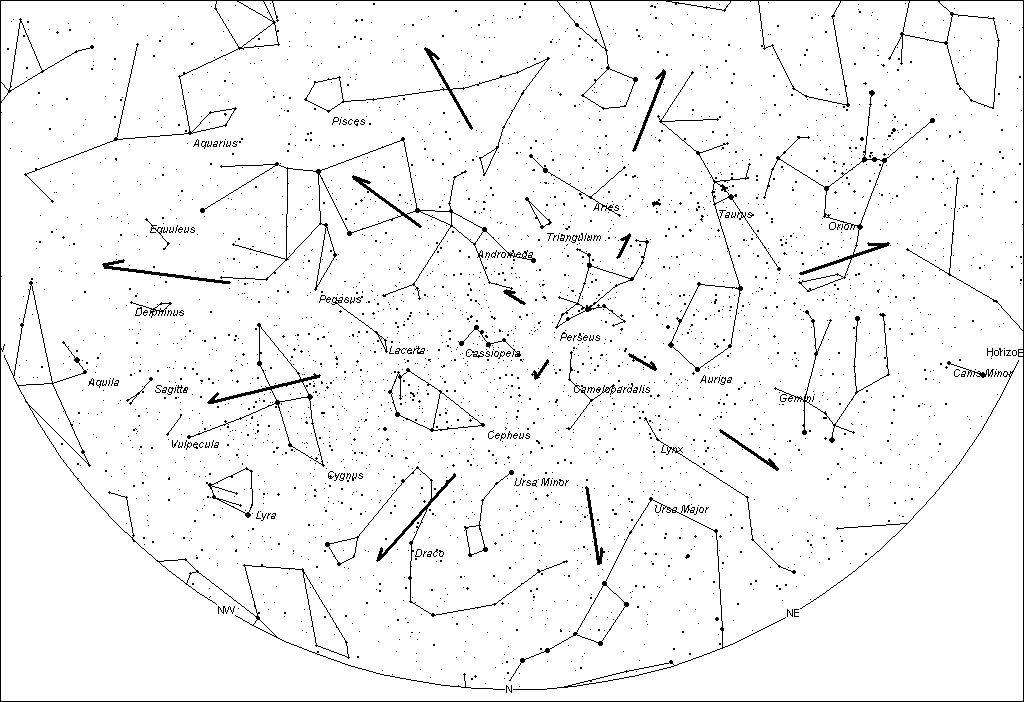
These are illustrations of Perseid meteors seen from latitude 40 N. near 0400 local summer time facing north on August 12th. This chart was created using SkyChart III Version 3.5.1 from Carina Software
The Perseids are active from July 13th through August 26th. Maximum activity is predicted to occur on the morning of August 12th, when rates in excess of 1 per minute may be seen from dark sky sites. On the morning of maximum the waxing gibbous moon will set between midnight and 0100 local summer time as seen from mid-northern latitudes. This will free up the prime observing hours from interfering moonlight.
As the sun sets in mid-August, the Perseid radiant lies near the northern horizon for viewers located in mid-northern latitudes. This is certainly not the prime time to view Perseid activity and the moon will further complicate matters. Some Perseid earthgrazers may be visible at this time but the bright moon will obscure all but the brightest meteors. For an hour or so beginning at dusk, you have the opportunity to see Perseid meteors that just skim the upper atmosphere. These are much different than Perseid meteors you see later in the night. With less resistance from air molecules these meteors last much longer and create long trails across the sky, often nearly stretching from horizon to horizon. With the low radiant altitude there will not be many of these meteors to see. Any that you do manage to witness will be memorable. Sky & Telescope magazine had a nice article on these meteors in their August 2014 issue.
As the night progresses the Perseid activity will slowly rise as the radiant gains altitude in the northeastern sky. Not until after midnight will the Perseid radiant gain sufficient altitude to produce pleasing results. Anytime from moonset to dawn will be the best time to see the most activity. Perseid meteors will appear in every portion of the sky. I would suggest facing toward the direction with the flattest horizon, devoid of any trees or hills that may block you view of the meteors. If all directions are favorable, then face toward the darkest portion of the sky, opposite any terrestrial lights that may interfere with viewing. Most people think that facing straight up is the best way to spot meteors. True, by facing the zenith you eliminate any terrestrial interference such as trees or hills. Unfortunately the column of air directly above you is the thinnest slice of atmosphere, therefore producing the least number of meteors. You are better off centering your field of view at approximately one-half the way up in the sky, high enough to avoid anything that may block your view.
The best Perseid rates will occur on a 5 night segment centered on August 12th. So if August 12th is cloudy you can still see good Perseid activity over the weekend. Just be sure to wait until the moon is low or has set before attempting to observe. You should try getting out on the 10th and 11th too as increasing rates will also be entertaining. Besides, the moon will set earlier on these nights allowing more time to watch under dark skies.
The best night for viewing the Perseids will the morning of August 12th. This year predictions by Mikhail Maslov and Esko Lyytinen predict that we will cross a part of the stream which has shifted closer to the Earth’s orbit by Jupiter[1]. Therefore rates could be up to twice as high compared to a normal Perseid display. Normal rates for this shower are usually around 60 meteors per hour as seen from rural observing sites. Therefore this year rates could exceed 100 per hour. Note that meteor activity is notoriously bunched, meaning that there are periods in which you will see no activity and other times when you will see several within seconds of each other. The quoted rates are an average over an hour’s time.
The Perseids also offer a good opportunity to photograph meteors. To accomplish this you need a camera capable of taking exposures of at least 60 seconds. It also advantageous to have a wide field lens such as a 24mm or 28mm. These lenses are normally “slow” with a focal ratio of 3.5 or higher. These lenses are still capable of capturing meteors but the lower the focal ration the better as “faster” lenses are more capable of capturing these fast streaks of light. If you simply aim your camera at the sky your time exposure will show the stars trailing through the frame. Meteors will appear as straight streaks of light crossing these star trails. Advanced astrophotographers use motorized mounts for their cameras to follow the stars and to avoid star trails. Meteor streaks will appear as they do in the sky, as streaks of light against a starry background.
2017 may also be a strong year for the Perseids but the waning gibbous moon will severely hinder observers by obscuring all but the brightest meteors. Another moon-free Perseid display will not occur until August 2018. Therefore it is highly recommended that you take advantage of the favorable circumstances occurring this year and get out and view this spectacle. We would appreciate hearing your results and impressions of this display!
[1] Rendtel, Juergen (2015) IMO 2016 Meteor Shower Calendar, Page 12

